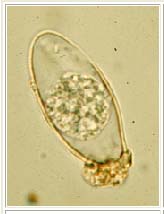|
|
| (11 intermediate revisions by 6 users not shown) |
| Line 1: |
Line 1: |
| | __NOTOC__ |
| [[Image:I. belli oocysts.jpg|thumb|Oocyst of Isospora belli]] | | [[Image:I. belli oocysts.jpg|thumb|Oocyst of Isospora belli]] |
| {{SI}} | | {{Isosporiasis}} |
|
| |
|
| {{Editor Help}} | | {{About1|Cystoisospora belli}} |
|
| |
|
| '''''Related Key Words and Synonyms:''''' Isospora infection | | {{CMG}}; '''Associate Editor-In-Chief:''' {{CZ}} |
|
| |
|
| == Overview ==
| | {{SK}} Isospora infection; cystoisoporiasis |
|
| |
|
| Isosporiasis is a human intestinal disease caused by a parasite called Isospora belli. | | ==[[Isosporiasis overview|Overview]]== |
|
| |
|
| == Epidemiology and Demographics == | | ==[[Isosporiasis historical perspective|Historical Perspective]]== |
|
| |
|
| '''Geographic Distribution:'''
| | ==[[Isosporiasis pathophysiology|Pathophysiology]]== |
|
| |
|
| Worldwide, especially in tropical and subtropical areas. Infection occurs in immunodepressed individuals, and outbreaks have been reported in institutionalized groups in the United States.
| | ==[[Isosporiasis causes|Causes]]== |
|
| |
|
| == Pathophysiology & Etiology== | | ==[[Isosporiasis differential diagnosis|Differentiating Isosporiasis from other Diseases]]== |
|
| |
|
| '''Etiologic agent:'''
| | ==[[Isosporiasis epidemiology and demographics|Epidemiology and Demographics]]== |
|
| |
|
| The coccidian parasite, Isospora belli, infects the epithelial cells of the small intestine, and is the least common of the three intestinal coccidia that infect humans.
| | ==[[Isosporiasis risk factors|Risk Factors]]== |
|
| |
|
| '''Life cycle:'''
| | ==[[Isosporiasis natural history, complications and prognosis|Natural History, Complications and Prognosis]]== |
| [[Image:Isospora_LifeCycle.gif|left|frame|Life cycle of Isospora belli]] | |
| <br clear="left"/>
| |
| At time of excretion, the immature oocyst contains usually one sporoblast (more rarely two) '''1'''. In further maturation after excretion, the sporoblast divides in two (the oocyst now contains two sporoblasts); the sporoblasts secrete a cyst wall, thus becoming sporocysts; and the sporocysts divide twice to produce four sporozoites each '''2'''. Infection occurs by ingestion of sporocysts-containing oocysts: the sporocysts excyst in the small intestine and release their sporozoites, which invade the epithelial cells and initiate schizogony '''3'''. Upon rupture of the schizonts, the merozoites are released, invade new epithelial cells, and continue the cycle of asexual multiplication '''4'''. Trophozoites develop into schizonts which contain multiple merozoites. After a minimum of one week, the sexual stage begins with the development of male and female gametocytes '''5'''. Fertilization results in the development of oocysts that are excreted in the stool '''1'''. Isospora belli infects both humans and animals.
| |
|
| |
|
| == Diagnosis == | | ==Diagnosis== |
| Microscopic demonstration of the large, typically shaped oocysts, is the basis for diagnosis. Because the oocysts may be passed in small amounts and intermittently, repeated stool examinations and concentration procedures are recommended.
| |
| If stool examinations are negative, examination of duodenal specimens by biopsy or string test (Enterotest®) may be needed.
| |
| The oocysts can be visualized on wet mounts by microscopy with bright-field, differential interference contrast (DIC), and UV fluorescence. They can also be stained by modified acid-fast stain.
| |
|
| |
|
| === History and Symptoms ===
| | [[Isosporiasis history and symptoms|History and Symptoms]] | [[Isosporiasis physical examination|Physical Examination]] | [[Isosporiasis laboratory findings|Laboratory Findings]] | [[Isosporiasis other diagnostic studies|Other Diagnostic Studies]] |
| Infection causes acute, non bloody [[diarrhea]] with crampy abdominal pain, which can last for weeks and result in malabsorption and weight loss. In immunodepressed patients, and in infants and children, the [[diarrhea]] can be severe. Eosinophilia may be present (differently from other protozoan infections).
| |
| | |
| === Laboratory Findings ===
| |
| '''''Microscopy:'''''
| |
| [[Image:Oocysts of Isospora belli.jpg|left|Oocysts of Isospora belli]] | |
| <br clear="left"/>
| |
| '''A''', '''B''', '''C''': Oocysts of Isospora belli. The oocysts are large (25 to 30 µm) and have a typical ellipsoidal shape. When excreted, they are immature and contain one sporoblast ('''A''', '''B'''). The oocyst matures after excretion: the single sporoblast divides in two sporoblasts ('''C'''), which develop cyst walls, becoming sporocysts, which eventually contain four sporozoites each. Images contributed by Georgia Division of Public Health.
| |
| | |
| [[Image:Comparison coccidian.jpg|left|Comparison of coccidian parasites]] | |
| <br clear="left"/>
| |
| Oocysts of Isospora belli can also be stained with acid-fast stains, and can be visualized by UV fluorescence on wet mounts, as illustrated in '''Figure 2'''. Three coccidian parasites that most commonly infect humans, seen in acid-fast stained smears ('''2A''', '''2C''', '''2F'''), bright-field differential interference contrast ('''2B''', '''2D''', '''2G''') and UV fluorescence ('''2E''', '''2H''', '''C'''. parvum oocysts do not autofluoresce).
| |
|
| |
|
| ==Treatment== | | ==Treatment== |
|
| |
|
| Trimethoprim-sulfamethoxazole is the drug of choice.
| | [[Isosporiasis medical therapy|Medical Therapy]] | [[Isosporiasis primary prevention|Primary Prevention]] | [[Isosporiasis secondary prevention|Secondary Prevention]] | [[Isosporiasis cost-effectiveness of therapy|Cost-Effectiveness of Therapy]] | [[Isosporiasis future or investigational therapies|Future or Investigational Therapies]] |
|
| |
|
| ==References== | | ==Case Studies== |
| #http://www.cdc.gov/ncidod/dpd/parasites/isospora/default.htm | | [[Isosporiasis case study one|Case #1]] |
| #http://www.dpd.cdc.gov/dpdx/HTML/isosporiasis.htm
| |
| #http://en.wikipedia.org/wiki/Isosporiasis
| |
|
| |
|
| | {{Protozoal diseases}} |
|
| |
|
| {{Protozoal diseases}} | | {{WikiDoc Help Menu}} |
| {{SIB}} | | {{WikiDoc Sources}} |
|
| |
|
| | [[Category:Disease]] |
|
| |
|
| [[Category:DiseaseState]]
| |
| [[Category:Infectious disease]]
| |
| [[Category:Parasitic diseases]] | | [[Category:Parasitic diseases]] |
|
| |
| {{WikiDoc Help Menu}}
| |
| {{WikiDoc Sources}}
| |
